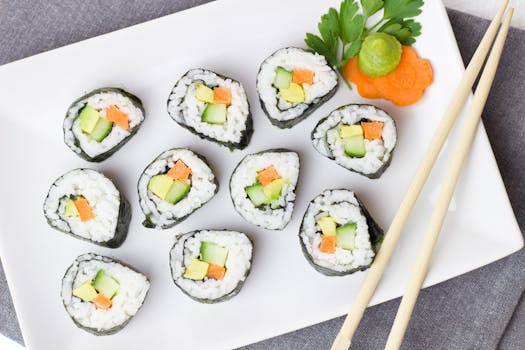Sushi at Home: A Step-by-Step Guide to Making Delicious Maki Rolls
Sushi has become a beloved dish worldwide, known for its fresh ingredients and artistic presentation. While many enjoy dining out at sushi restaurants, making sushi at home can be a fun and rewarding experience. This article will guide you through the process of creating delicious maki rolls, a popular type of sushi that is both versatile and easy to prepare.
Understanding Maki Rolls
Maki rolls, or maki-zushi, are cylindrical rolls of sushi rice and various fillings wrapped in seaweed (nori). They can be filled with a variety of ingredients, including fish, vegetables, and even fruits. The beauty of maki rolls lies in their adaptability, allowing you to customize them to your taste preferences.
Types of Maki Rolls
Before diving into the preparation, it’s essential to understand the different types of maki rolls:
- Hosomaki: Small rolls with a single filling, typically cut into six to eight pieces.
- Uramaki: Inside-out rolls where the rice is on the outside, often topped with sesame seeds or fish roe.
- Futomaki: Larger rolls filled with multiple ingredients, usually cut into thicker slices.
Essential Ingredients and Tools
To make maki rolls at home, you will need the following ingredients and tools:
Ingredients
- Sushi Rice: Short-grain rice is ideal for sushi due to its sticky texture.
- Nori: Seaweed sheets used to wrap the rolls.
- Fillings: Common options include fresh fish (like tuna or salmon), avocado, cucumber, and crab meat.
- Sushi Vinegar: A mixture of rice vinegar, sugar, and salt to season the rice.
- Wasabi and Soy Sauce: For serving and enhancing flavor.
Tools
- Sushi Mat: A bamboo mat for rolling the sushi.
- Sharp Knife: For cutting the rolls cleanly.
- Rice Cooker or Pot: To cook the sushi rice.
- Mixing Bowl: For combining the rice with sushi vinegar.
Step-by-Step Guide to Making Maki Rolls
Now that you have your ingredients and tools ready, follow these steps to create your own maki rolls:
Step 1: Prepare the Sushi Rice
Start by rinsing 2 cups of sushi rice under cold water until the water runs clear. This removes excess starch and prevents the rice from becoming gummy. Cook the rice in a rice cooker or pot according to the package instructions. Once cooked, transfer the rice to a mixing bowl and gently fold in 1/4 cup of sushi vinegar. Allow it to cool to room temperature.
Step 2: Prepare Your Fillings
While the rice cools, prepare your fillings. Slice vegetables like cucumber and avocado into thin strips. If using fish, ensure it is sushi-grade and cut into long, thin pieces. You can also experiment with cooked ingredients like tempura shrimp or grilled chicken.
Step 3: Assemble the Maki Roll
Place a sheet of nori on your sushi mat, shiny side down. Wet your hands to prevent sticking, then take a handful of sushi rice and spread it evenly over the nori, leaving about an inch at the top edge. Lay your chosen fillings in a line across the center of the rice.
Step 4: Roll the Sushi
Using the sushi mat, carefully lift the edge closest to you and start rolling away from you, applying gentle pressure to form a tight roll. Continue rolling until you reach the exposed edge of the nori. Use a little water to seal the edge.
Step 5: Cut and Serve
With a sharp knife, slice the roll into six to eight pieces. Wipe the knife with a damp cloth between cuts to ensure clean edges. Serve your maki rolls with wasabi and soy sauce for dipping.
Tips for Success
To enhance your sushi-making experience, consider the following tips:
- Use high-quality ingredients for the best flavor.
- Experiment with different fillings to find your favorite combinations.
- Practice makes perfect; don’t be discouraged if your first rolls aren’t perfect.
Conclusion
Making sushi at home can be a delightful culinary adventure. By following this step-by-step guide, you can create delicious maki rolls tailored to your taste. Remember to have fun with the process, experiment with different ingredients, and enjoy the fruits of your labor. With practice, you’ll impress your friends and family with your sushi-making skills, bringing a taste of Japan right to your kitchen.
